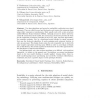Free Online Productivity Tools
i2Speak
i2Symbol
i2OCR
iTex2Img
iWeb2Print
iWeb2Shot
i2Type
iPdf2Split
iPdf2Merge
i2Bopomofo
i2Arabic
i2Style
i2Image
i2PDF
iLatex2Rtf
Sci2ools
FMSD
2006
2006
Dealing with practical limitations of distributed timed model checking for timed automata
Two base algorithms are known for reachability verification over timed automata. They are called forward and backwards, and traverse the automata edges using either successors or predecessors. Both usually work with a data structure called Difference Bound Matrices (DBMs). Although forward is better suited for on-the-fly construction of the model, the one known as backwards provides the basis for the verification of arbitrary formulae of the TCTL logic, and more importantly, for controller synthesis. Zeus is a distributed model checker for timed automata that uses the backwards algorithm. It works assigning each automata location to only one processor. This design choice seems the only reasonable way to deal with some complex operations involving many DBMs in order to avoid huge overheads due to distribution. This article explores the limitations of Zeus-like approaches for the distribution of timed model checkers. Our findings justify why close-to-linear speedups are so difficult
Related Content
| Added | 12 Dec 2010 |
| Updated | 12 Dec 2010 |
| Type | Journal |
| Year | 2006 |
| Where | FMSD |
| Authors | Víctor A. Braberman, Alfredo Olivero, Fernando Schapachnik |
Comments (0)

